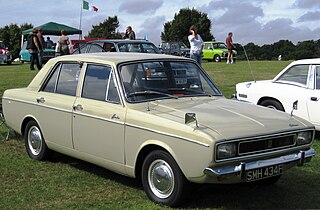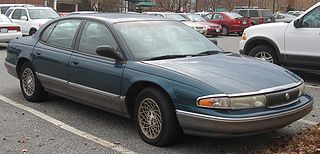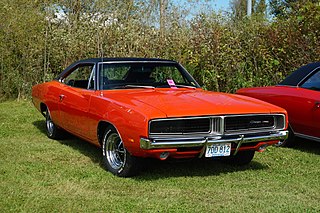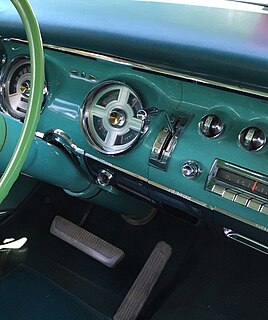
Bristol Cars were manufacturers of hand-built luxury cars headquartered in Bristol, England. After being placed in receivership and being taken over in 2011, it entered liquidation in February 2020.

The Chrysler 300 "letter series" are high-performance personal luxury cars that were built by Chrysler in the U.S. from 1955 to 1965 and were a sub-model from the Chrysler New Yorker. After the initial year, which was named C-300 for its standard 300 hp (220 kW) 331 cu in (5.4 L) FirePower V8, the 1956 cars were designated 300B. Successive model years were given the next letter of the alphabet as a suffix, reaching the 300L by 1965, after which the model sequence was discontinued while the "300" remained. At its introduction it was advertised as "America's Most Powerful Car".

Rootes Arrow was the manufacturer's name for a range of cars produced under several badge-engineered marques by the Rootes Group from 1966 to 1979. It is amongst the last Rootes designs, developed with no influence from future owner Chrysler. The range is almost always referred to by the name of the most prolific model, the Hillman Hunter.

The Chrysler New Yorker is an automobile model that was produced by Chrysler from 1940 until 1996, serving for several decades as the brand's flagship model, or as a junior sedan to the Chrysler Imperial luxury brand. A trim level named the "New York Special" first appeared in 1938 and the "New Yorker" name debuted in 1939. The New Yorker name helped define the Chrysler brand as a maker of upscale models, priced and equipped to compete against upper-level models from Buick, Oldsmobile and Mercury.

The Dodge Charger is a model of automobile marketed by Dodge in various forms over seven generations since 1966.

The Plymouth Valiant is an automobile which was marketed by the Plymouth division of the Chrysler Corporation in the United States from the model years of 1960 through 1976. It was created to give the company an entry in the compact car market emerging in the late 1950s. The Valiant was also built and marketed, without the Plymouth brand, worldwide in countries including Argentina, Australia, Brazil, Canada, Finland, Mexico, New Zealand, South Africa, Sweden and Switzerland, as well as other countries in South America and Western Europe. It became well known for its excellent durability and reliability, and was one of Chrysler's best-selling automobiles during the 1960s and 1970s, helping to keep the company solvent during an economic downturn.

The Ford Zephyr is an executive car manufactured by Ford of Britain from 1950 until 1972. The Zephyr and its luxury variants, the Ford Zodiac and Ford Executive, were the largest passenger cars in the British Ford range from 1950 until their replacement by the Consul and Granada models in 1972.

The Chrysler Valiant was a full-size car which was sold by Chrysler Australia between 1962 and 1981. Initially a rebadged locally assembled Plymouth Valiant from the United States, from the second generation launched in 1963, the Valiant was fully manufactured in Australia. It was sold locally but also in New Zealand and South Africa, with smaller numbers also exported to South-East Asia and the United Kingdom.
A semi-automatic transmission is a "theoretical" multiple-speed transmission where part of its operation is automated, but the driver's input would be required to launch the vehicle from a standstill and to manually change gears. Semi-automatic transmissions were exclusively used in motorcycles and are based on conventional manual transmissions or sequential manual transmissions, but use an automatic clutch system. But some semi-automatic transmissions have also been based on standard hydraulic automatic transmissions with torque converters and planetary gearsets.

TorqueFlite is the trademarked name of Chrysler Corporation's automatic transmissions, starting with the three-speed unit introduced late in the 1956 model year as a successor to Chrysler's two-speed PowerFlite. In the 1990s, the TorqueFlite name was dropped in favor of alphanumeric designations, although the latest Chrysler eight-speed automatic transmission has revived the name.

PowerFlite is a two-speed automatic transmission engineered and produced by the Chrysler Corporation and used in their passenger cars from 1954 to 1961. Production began in late 1953 and the simple and durable PowerFlite remained available on Plymouths and Dodges through the 1961 model year.

The Mercury Colony Park is an American luxury full-size station wagon that was marketed by the Mercury division of Ford Motor Company between 1957 and 1991. Distinguished by its simulated wood-grain paneling, the Colony Park was marketed as either the premium-trim or the sole full-size station wagon offering of the division. Following the 1960 demise of Edsel, full-size Mercury vehicles shared bodywork with Ford; the Colony Park served as the counterpart of the Ford Country Squire through 1991.

The Humber Super Snipe is a car which was produced from 1938 to 1967 by British-based Humber Limited.

The Vauxhall Cresta is a British full-size car which was produced by Vauxhall from 1954 to 1972. The Cresta was introduced in 1954 as an upmarket version of the Vauxhall Velox, itself a six-cylinder version of the Vauxhall Wyvern. The Cresta models were the E (1954–1957), PA (1957–1962), PB (1962–1965) and PC (1965–1972). The Viscount (1966–1972) was an upmarket Cresta PC.

The Lamborghini Espada is a 4-seat grand touring coupé built by Italian car manufacturer Lamborghini between 1968 and 1978.

The Dodge Charger (1966) also known as Dodge Charger (B-body) is a mid-size automobile that was produced by Dodge from 1966 to 1978, and was based on the Chrysler B platform.

The Moskvitch-408 series is a large family car produced by the Soviet car manufacturer MZMA/AZLK between 1964 and 1975. The first prototype was made in 1960.

The Bristol 408 is a British luxury car made by Bristol Cars between 1963 and 1966. Unusually for Bristol, a slightly revised version was launched during the middle of the model's production run in 1965 and known as the 408 Mark II.

The Hillman Super Minx is a family car which was produced by Hillman from 1961 to 1967. It was a slightly larger version of the Hillman Minx, from the period when the long-running Minx nameplate was applied to the "Audax" series of designs.

Car controls are the components in automobiles and other powered road vehicles, such as trucks and buses, used for driving and parking.



















